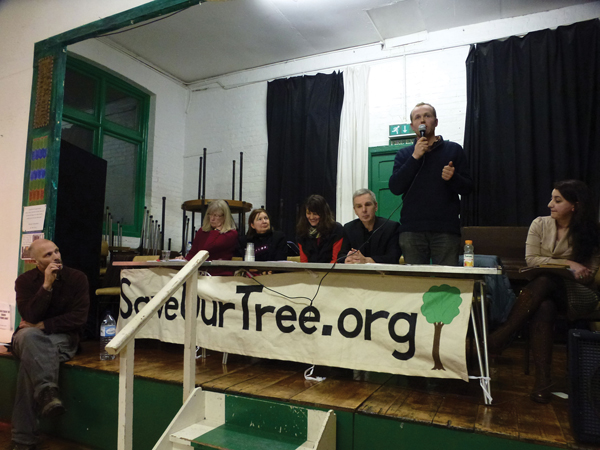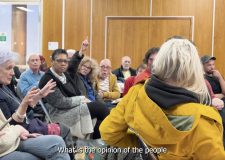Elm tree divides opinion in Brighton
If a tree is known by its fruits, the campaign to stop an elm being felled has shown the true colours of people living near the Seven Dials.
Frank le Duc reports

A silent elm tree next to the Seven Dials has asked an awful lot of questions of many people over the past few weeks. For a few days it was home to two protesters trying to prevent council contractors from cutting it down. And it has been the focus of some intense scrutiny of politicians and officials as they wrestle with principles, process and pragmatism.
The Green administration has been reminded of one of the sayings of St Basil: “A tree is known by its fruit and a man by his deeds.” But the decision in question was a cross-party one. Few making the decision – to approve a change to the road layout at the Seven Dials – seemed to appreciate that it would involve felling a mature elm tree.
The loss of the elm was not in the original proposal. It seems likely that consultation responses might otherwise have been different. This is a key fact that could help campaigners if they take Brighton and Hove City Council to court. And they have discussed the possibility of a judicial review.
Meeting our needs
The prospect of felling the tree came about because those drawing up the scheme at the Dials were trying to incorporate responses given during the consultation. One influential response came from Jon Hastie, the involvement officer for the Fed Centre for Independent Living, which helps disabled people.
Dr Hastie said: “At present the tree in Vernon Terrace significantly narrows the pathway and creates an unnecessary obstacle for wheelchair users. While we appreciate the need for greenery and trees in any street design, it is important this is done in a way that meets the needs of all users and does not create narrow or uneven streets. We call for this tree to be removed or relocated in the new design of the area.”
But even when people living near by were told that a tree would be cut down, they say that they were not told that it would be an elm. Many trees are protected by preservation orders. And in an era when thousands of trees have been lost to elm disease, the sensitivity around the healthy specimen at the Dials is hardly surprising.
Some have criticised the Green administration over this issue, even though the Seven Dials scheme was approved by Labour and Conservative councillors too. Yet many of those campaigning to save the tree are supporters of the Greens.
In protest
One of the two people who camped up the tree, Stephen Hendry, said:
“As a consequence of this campaign, I feel motivated to stand as a councillor for the Greens. It’s the first time I’ve been up a tree for a protest. I was totally and utterly petrified. I even screamed at one point. I honestly thought I was going to die.”
He spent two days and nights up the tree with Tom Druitt who is best known as the boss of the Big Lemon bus company. Mr Druitt has previously camped in a tree to protest against a road scheme. And as a result of his six-week protest in Combe Haven against the Hastings and Bexhill link road, he was arrested and charged with aggravated trespass and obstructing a High Court official. He denies the charges and is expected to stand trial in the autumn.
He said: “This is on my doorstep. Everybody involved lives within about 50 yards of the Seven Dials. We went up the tree on Wednesday evening [6 March] and came down late on Friday when the council agreed to a stay of execution. Senior officers said that they would look at suggestions and we’re working with them to try to find an alternative.”
“Opponents and supporters are watching to see if they can find a solution that keeps them true to their roots”
His partner, Green councillor Alex Phillips, was part of the council’s Transport Committee which approved the Seven Dials scheme. On Twitter she said: “Most of the public didn’t know about the elm being taken down. It clearly wasn’t explicit enough in the consultation. I agree with the scheme, just not this. I raised the concerns that were raised with me at the time. The tree wasn’t one of those.”
A different path
The tree is in the Brighton Pavilion constituency represented by Green MP Caroline Lucas, who was quick to lobby the council about it. She said: “This tree is hugely loved by many people. They don’t want to see it come down. At the very minimum we need to have a round-table discussion with the council, with residents, with tree experts to look at other alternatives that might be possible rather than felling what is clearly a very much-loved tree.”
Green activist Duncan Roy was one of the first to make people aware of the threat to the elm. He wrote on his Scrapper Duncan website before a public meeting last week: “We will not be revisiting the plan to redevelop the Seven Dials roundabout, which has already been subject to a nine-month public consultation process. The problem was that this process omitted to mention that an elm would be felled, which is very odd because the city of Brighton and Hove is the custodian of the so-called National Elms Collection.”
One of the tree-top protesters, Stephen Hendry, said afterwards that the ideas so far included raising the level of the pavement with porous concrete and realigning the road.
He said that the pavement was wider on the opposite side of the road, allowing some give and take. And referring to pavement around the elm, he added: “There’s a wall that impedes the traffic flow. That wall could be purchased and demolished.”
When he and Mr Druitt ended their protest, one of the council’s most senior officials, executive director Geoff Raw, said: “The community-approved design has been widely consulted on, including in a public meeting in December where the need to remove the tree was announced. The decision to proceed was taken by the cross-party Transport Committee in January and includes the planting of ten more trees which would see Seven Dials become even greener.
“At the moment the tree to be felled is obstructing people’s view of the junction and oncoming traffic as they cross the road and its root is damaging the footpath, causing accessibility problems. Felling a large elm is not a decision taken lightly. It is an absolute last resort. It’s the council’s dedication to our elms which has ensured that we have the finest collection in the country. We are listening to concerns and we’re happy to look at and consider alternative proposals.”
Root pruning
Local resident Nigel Furness said: “How encouraging to read of local residents and Green activists campaigning to prevent the wanton destruction of the Seven Dials elm. But how depressing to think it is a Green council at the root of these plans. The council claims the buttress roots of the tree are reducing mobility scooter and buggy access on the Vernon Terrace pavement, which in part is true.
“The remedy, however, is root pruning – something which until recent years was carried out on a regular three-year basis thus preventing such problems arising in the first place. If the roots are too large, raise the pavement above them on a level slope. As for the point that the elm will restrict drivers’ views of the proposed zebra crossing in Vernon Terrace when turning south off the Dials, simply leave the lights at this point.”
The stay of execution was due to last until Friday. The Seven Dials scheme will take until the end of the year. Of course, delays can be costly. But campaigners, politicians and officials are all keen to avoid the even costlier prospect of a High Court battle.
They may be mindful too of the words of the post-war US presidential candidate, Adlai Stevenson, who said: “A hypocrite is the kind of politician who would cut down a redwood tree, then mount the stump and make a speech for conservation.” The Greens’ opponents and supporters are watching to see whether they can find a solution that keeps them true to their roots.
Brighton & Hove City Council leader Jason Kitcat on Brighton Fringe
Each May we’re lucky enough to host both the most established mixed arts festival and the largest arts festival in England. Both the Brighton Festival and the Brighton Fringe festivals launched recently. The festivals run throughout May, offering a huge variety of drama, music, art, talks and interactive events for residents and visitors to the city.
The headline guest director for this year’s Brighton Festival is Michael Rosen, celebrated poet, writer, broadcaster, and former Children’s Laureate. Among the 370 performances and 154 events across the city are discussions exploring literature and language throughout the ages, ‘earfilms’ which tell stories through only sound, and a wonderful children’s parade.
Meanwhile, Brighton Fringe has over 700 events, 165 of which are free to all. In their programme this year are a 360’ inflatable cinema dome, open air Shakespeare in St Ann’s Well Gardens, and tours behind the scenes of Brighton Station.
Between them, these two fantastic art festivals attract over 350,000 people to their events and performances, and bring tens of millions of pounds
to the local economy.
These festivals showcase global stars, but also give a platform to many local organisations and companies from our creative sector. In Brighton & Hove we have over 1,500 companies involved in areas like advertising, architecture, design, music, theatre, computer games, television and radio. They’ve established a critical mass of expertise and skills, and continue to attract new companies to the city.
Brighton & Hove’s reputation for culture and the arts is also being amplified through our recently-launched prospectus for investment in the city, and our Economic Strategy which is currently being refreshed. Support for our local creative industries is critical for our economic future, and we will continue doing all we can to promote Brighton & Hove as an industry-leader. Meanwhile I hope everyone enjoys all the events planned for this year.




















